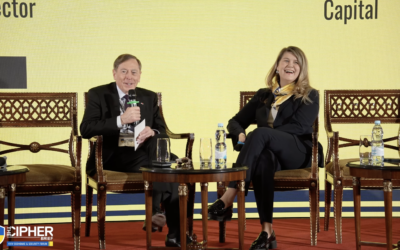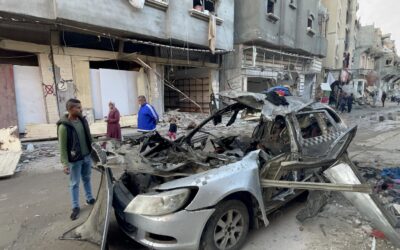
At Kyiv Summit, a Case For Investing in Wartime Ukraine
SUBSCRIBER+EXCLUSIVE INTERVIEW — While Ukraine deals with shortages of troops, munitions, and equipment for its air defenses, some Ukrainians are teaming up with foreign investors […] More
Bottom Line Up Front
Protests erupted throughout Iran on November 15 in response to a sudden, late-night government announcement that fuel prices would increase 50 percent for a monthly allotment of 15 gallons and 300 percent for purchases greater than that amount. The government presented the price hike as a consensus decision of the three branches of government—executive, parliamentary, and judiciary—intended to free up budgetary funds for added cash transfers to 75 percent of the country’s lowest earning families. Despite the stated rationale for the price hikes, which comport with longstanding recommendations of economists to curb fuel subsidies, protests spread over the next two days to over 100 cities. Some escalated into riots in which banks, gas stations, and police posts were burned, and highways were purposely blocked by motorists. Following the pattern of similar unrest in late 2017, stated grievances of protesters evolved from economic dissatisfaction to calls for the abolition of the Islamic government outright and for the regime to cease spending national funds on regional interventions in Iraq, Lebanon, the Palestinian territories, and Yemen.
The regime has used the same playbook in its response to the unrest that it used successfully to end the 2017 demonstrations. Internet access was shut down to hinder the protest’s organizers. Security organs such as the Islamic Revolutionary Guard Corps (IRGC) and its militia, the Basij, allowed peaceful protests to proceed, resorting to the use of force only in selected cases of organized violence against government installations and public property. As he has done during similar past waves of unrest, Iran’s Supreme Leader Ali Khamene’i, blamed the protests on agitation by external powers (the United States, Saudi Arabia), as well as by the exiled oppositionist Mojahedin-e-Khalq Organization (MeK) and the son of the ousted Shah of Iran. The Supreme Leader’s assertions seemed to mirror an early November charge by Turkish President Recep Tayyip Erdogan that foreign powers (implicitly referring to Saudi Arabia and perhaps also the United States) were seeking to use protests in Iraq and Lebanon to export unrest into Iran.
While threatening a more intense crackdown against protesters who go on to commit acts of violence, the Supreme Leader’s simultaneous expression that the dissatisfaction over fuel price hikes were ‘understandable’ appeared, at least initially, to enervate the protests after three days. The effect of Khamene’i’s concessionary comments might reflect the public realization that the government faces difficult choices in coping with the effect of U.S. sanctions imposed by the Trump administration since 2018. Despite that understanding of the financial constraints on the government, protesters were agitated by the immediate, tangible effect of the fuel subsidy reduction as compared to the uncertain promise of an increased cash transfer. Protesters also perceive that the subsidy reduction might not be necessary if the government was willing to reduce spending on the IRGC and its regional interventions that offer unclear benefits to the average Iranian.
Despite the growing unrest, there is little indication that the government will offer any meaningful concessions to the protesters. A few parliamentarians who disagreed with the fuel price hikes resigned, claiming they were not adequately ‘consulted’ on the move, but the Supreme Leader’s backing for the decision likely precludes a rollback in the price increases. In contrast to recent protests in Iraq and Lebanon, neither President Hassan Rouhani nor any other senior Iranian official has resigned, or offered to resign, as a concession to the demonstrators. Whereas Trump administration officials do not expect popular unrest fueled by U.S. sanctions to topple Iran’s regime, there is a hope that Iranian public dissatisfaction over economic conditions can compel the regime to curtail its regional interventions. Yet, that U.S. expectation, too, is likely to be frustrated. The regime considers its foreign interventions to be core to Iran’s national security, and no amount of economic pressure has proved sufficient to force the regime to retrench. Nor has any Iranian official suggested that Iran would restrain any of its regional activities – either because of resource constraints or as a result of any new negotiation with the Trump administration. It remains unlikely that the protests will produce results favorable to U.S. interests.
Related Articles

SUBSCRIBER+EXCLUSIVE INTERVIEW — While Ukraine deals with shortages of troops, munitions, and equipment for its air defenses, some Ukrainians are teaming up with foreign investors […] More

SUBSCRIBER+EXCLUSIVE INTERVIEW — With a mere 1.2 million citizens, Estonia is among NATO’s smallest members, but its contributions to Ukraine have led the pack by […] More

SUBSCRIBER+EXCLUSIVE BRIEFING — Drone weapons are part of the daily narrative of the war in Ukraine – from Russia’s use of Iranian drones against infrastructure […] More

SUBSCRIBER+ EXCLUSIVE ANALYSIS — Iran’s retaliatory strikes against Israel this weekend were both a potentially game-changing, historic first — and an underwhelming response. Historic, because […] More

SUBSCRIBER+EXCLUSIVE INTERVIEW — Ukraine was hit by a fresh round of Russian missile attacks on Thursday, strikes that targeted and damaged the country’s power grid […] More

SUBSCRIBER+ EXCLUSIVE REPORTING — The Israeli drone strike that killed three adult sons (who Israel says were Hamas operatives) and four grandchildren of Hamas’s Qatar-based […] More
Search